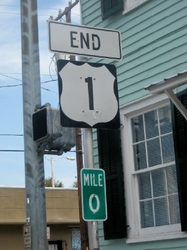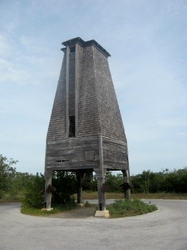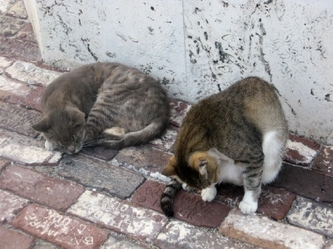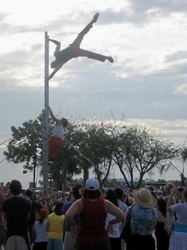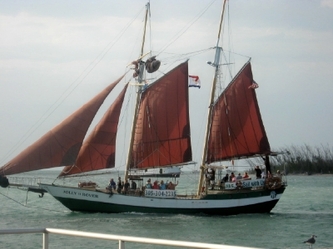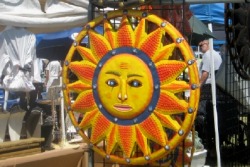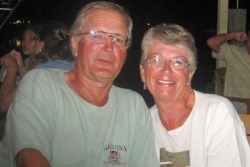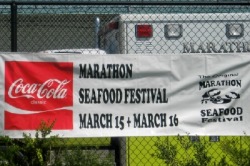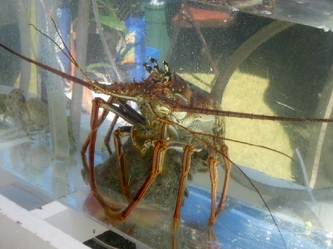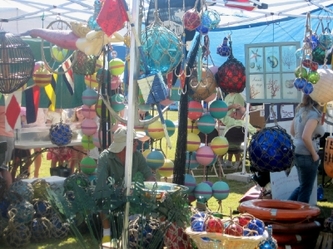
We were expecting the call, but we thought it would still be a few more weeks in coming. Easter Sunday night, after we had just hung up with our daughter, she called back to say she was on her way to the hospital. Troy Brendan Hawkins was born the next morning at 9:19am. We are thrilled to welcome him, but now the pressure was on. We had to get north as soon as we could, so we could go see him. It was time to wake up and get moving.
Running down the checklist
We wanted to move the boat far enough north that we could leave it for a week or 2 and have a reasonable drive to southern Virginia. From Marathon, that drive would take 2 days. So we figured we needed to get as far north as St. Mary’s, GA or Charleston, SC, where we knew of places where the rates were reasonable for a week’s stay and we would have a more reasonable drive.
Sitting in one place for 2 months, cruisers get lazy. It’s easy to get water, fuel, groceries, and since you aren’t moving the boat, you don’t have to worry too much about the detritus that accumulates on galley counters, in the cockpit on the nav station and other places that will not be secure once the boat gets moving. As for the working parts of the boat, such as the engine. . . what’s that? Well, it’s not that bad, but you get my point. We had to whip the boat and ourselves back into shape, which generated a flurry of activity. Since this might be a useful checklist for other boaters, we put in that form below:
1. Fill up with the good stuff and dump the bad
Re-fill water tanks
We chose to do this by making several dinghy runs to fill jugs, which we poured into the water tanks on the boat. We overestimated a little and ended up with a couple of extra jugs – one of which we used before we left.
Top off Orion’s diesel fuel tank and re-fill jugs on deck
We prefer to use our diesel jugs on the boat to fill the tank and then re-fill them for re-filling further up our route. This prevents the problems of the high speed pumps causing overflows and Dave can usually hear the tank fill, so he knows it’s full, without overflowing.
Re-provision groceries
We had access to a car for a day, so we could get all the heavy stuff to the boat. We waited until a couple of days before our likely travel date to get the fresh groceries.
Change generator oil
Before getting our solar panels and discovering the problem with the battery terminal, we had run the generator for dozens of hours in an attempt to equalize the batteries. This meant the generator reached its hundred hours of use threshold earlier than expected, which meant an oil change was required. Doing it in Marathon gave us the advantage of an easy place to re-cycle the used oil.
Re-fill propane
This involved a dinghy ride and a short walk to the nearest gas station. Thank goodness for our wheeled cart!
Pump-out holding tank
Although Marathon provides a pump-out boat, which comes to the boat on a regular schedule, we made arrangements to alter this schedule to have our last pump-out on the day before we (hopefully) would be leaving.
2. Get the working parts of the boat ready to work
Check engine fluids (oil, water, fuel filters)We had been running the engine on at least a weekly basis, under load, since we arrived in Marathon. (We typically did this by running the engine in reverse for about 15 minutes.) Therefore, there were no surprises here. The oil level was full, the fuel filters clean and the raw water was full. Dave checked the belts and tightened them as necessary and checked the antifreeze level, which was fine.
Check out batteries
We have lead-acid batteries, so Dave checked the water level in each of the cells to ensure they were topped off. Then, between the solar panels and the generator, ensured they were fully charged. This included a couple of batteries we typically have off-line for use in emergencies. If we ended us sailing a lot while underway (which we wanted to do), we wouldn’t be as likely to run into a problem with having enough power to run the instruments, lights, etc, requiring us to run the engine unnecessarily.
Check out lights
For most lights (bow and stern navigation lights, steaming light), this was as simple as turning them on to verify they were working. However, Dave had purchased another LED anchor lightbulb in hopes that this would fit our fixture on top of the mast. So, Cathy made a trip up the mast in hopes she could finally be successful in changing the lightbulb. Once more, it didn’t work. The lightbulb seemed to fit the fixture, but it wouldn’t light. The lightbulb itself worked, but not in the fixture. We ended up simply replacing the existing incandescent lightbulb with a new one and went back to the drawing board on the LED light. Maybe someday . . .
3. Clean everything you can
Clothes
It’s funny how you feel like you’ll never have a chance to do laundry again once you get underway. At any rate, Cathy took advantage of another friend’s offer of a car to do some laundry at the bigger facilities at a nearby Laundromat.
Boat bottom
Although Dave now had the equipment to do this himself, with his eye inflammation, he wanted to take no chances of picking up something in the water that would cause the situation to regress. So, we hired a diver (Barnacle Bill) to come and dive on the boat. He did a very thorough job, working on the boat for at least an hour to clean the bottom, running gear, thru-hulls and change the zinc. (The old one was in surprisingly good shape.) Dave discovered that it was Barnacle Bill’s birthday, too (making him easily old enough to be his father.) So, while he worked on the boat, Cathy made him some “birthday” brownies, with a candle in them, which made him smile.
Dinghy
The place to do this in Marathon is on Sombrero Beach. We dinghy’d down Sister’s Creek from the mooring field, beached the dinghy, emptied it, removed the motor and flipped it on the sand. Then we started scraping. And scraping. And scraping. Two months in the warm waters of Boot Key Harbor were not kind to the dinghy bottom. After almost an hour with both of us working on it, we decided it was good enough. (Maybe it would be worth investing in dinghy bottom paint.) A final scrub would be required when we hauled the dinghy on board to leave, but it would be much easier with the hard work done.
Air
Clean the air? Well, with Cathy’s allergies, we have to run the ozone generator inside the boat to reduce the mold spores floating around. We took advantage of Dave’s time charging the batteries with Honda generator to provide the 110 power to run the ozone generator in the aft cabin and main saloon. And Cathy could tell the difference. It works!
Cockpit window
These have to be treated carefully, but they can get amazing dirty both inside and out from just sitting. Cathy used vinegar and water to clean them so we wouldn’t have any sun glare while underway.
4. Plan the trip
Prepare and load route(s)
Although we should already have most of these routes loaded from our trip down, Dave noted that the gulf stream had moved in closer to shore in recent days. This meant that we might be able to take advantage of its strong northerly current on any possible offshore runs we made. If so, we could make some great time going north. He mapped out some routes that would take advantage of this on a number of hops north from Marathon to Lake Worth. These could be activated if we found the weather.
Check weather
It’s amazing how careless you get about checking weather when you don’t move anywhere. We became vigilant about listening and recording the NOAA weather forecasts on VHF, listening to Chris Parker on the ham radio and checking the forecasts online. We had been experiencing almost a week of strong northeast winds. They would need to be coming from the south or west to make for a comfortable trip east up the keys to the mainland and then anything but north to travel northwest up the Florida coast.
Talk to potential cruising companions
With the need to travel north quickly, we wouldn’t be able to travel with Fortunate and Slow Dancin’, who would be traveling more slowly north. So, we started talking to others in the harbor who had plans to go north. There was a buddy boat board in the marina office that gave the boat names of others planning to leave around the same time. We spoke to Mary Lee, but they were traveling with another boat that wanted to travel the ICW through the Keys to Miami. This was too shallow for us to consider. We also spoke to Solveig of Lorn, a Scottish couple who wanted to travel up to Fort Lauderdale to leave the boat. They were more likely to travel on our schedule, so we committed to staying in touch. We also started trying to talk to Pat and Fred on Marianna on the ham radio to see if we could hook up with them. It looked like it might be possible that our paths could cross, but it was too early to tell. While listening for Marianna, we heard Bonnie Lass as well and spoke to them briefly while they were in Wardewick Well in the Exumas.
6. Miscellaneous other stuff
Stow loose items
Cathy worked her through the boat, organizing the various cabins, getting everything possible put. It would mean less “activity” below in large seas offshore.
Haircut
It was hard to let the easy access to haircuts pass us by before we left. There were 2 or 3 boaters in the harbor who gave haircuts, so we both headed to shore one Sunday afternoon and got a haircut under the tree by the marina. Connie on Te Oigo (“I Hear You”) did a great job for both us.
Get clearance from the eye doctor
Before we could commit to a travel date, Dave needed to have his final check with the ophthalmologist he had been seeing for his iritis. This happened on March 31st, when he was given, if not exactly a clean bill of health, an OK that things were looking good enough for him to travel. He would need a couple of follow-up visits over the next couple of months, but all signs were that the healing would continue as long as we were vigilant with the drops over the remaining 6 weeks. Happily, this schedule had changed from a punishing 19 hourly drops a day to only 6, with a schedule to reduce further in the next few days. This put us in pretty good shape to move once we found the weather. The only big thing left to do would be to stow the dinghy and motor on deck and take off the solar panels, but these would have to wait until just before we left, since we used them so often.
What about some fun stuff?
Running down the checklist
We wanted to move the boat far enough north that we could leave it for a week or 2 and have a reasonable drive to southern Virginia. From Marathon, that drive would take 2 days. So we figured we needed to get as far north as St. Mary’s, GA or Charleston, SC, where we knew of places where the rates were reasonable for a week’s stay and we would have a more reasonable drive.
Sitting in one place for 2 months, cruisers get lazy. It’s easy to get water, fuel, groceries, and since you aren’t moving the boat, you don’t have to worry too much about the detritus that accumulates on galley counters, in the cockpit on the nav station and other places that will not be secure once the boat gets moving. As for the working parts of the boat, such as the engine. . . what’s that? Well, it’s not that bad, but you get my point. We had to whip the boat and ourselves back into shape, which generated a flurry of activity. Since this might be a useful checklist for other boaters, we put in that form below:
1. Fill up with the good stuff and dump the bad
Re-fill water tanks
We chose to do this by making several dinghy runs to fill jugs, which we poured into the water tanks on the boat. We overestimated a little and ended up with a couple of extra jugs – one of which we used before we left.
Top off Orion’s diesel fuel tank and re-fill jugs on deck
We prefer to use our diesel jugs on the boat to fill the tank and then re-fill them for re-filling further up our route. This prevents the problems of the high speed pumps causing overflows and Dave can usually hear the tank fill, so he knows it’s full, without overflowing.
Re-provision groceries
We had access to a car for a day, so we could get all the heavy stuff to the boat. We waited until a couple of days before our likely travel date to get the fresh groceries.
Change generator oil
Before getting our solar panels and discovering the problem with the battery terminal, we had run the generator for dozens of hours in an attempt to equalize the batteries. This meant the generator reached its hundred hours of use threshold earlier than expected, which meant an oil change was required. Doing it in Marathon gave us the advantage of an easy place to re-cycle the used oil.
Re-fill propane
This involved a dinghy ride and a short walk to the nearest gas station. Thank goodness for our wheeled cart!
Pump-out holding tank
Although Marathon provides a pump-out boat, which comes to the boat on a regular schedule, we made arrangements to alter this schedule to have our last pump-out on the day before we (hopefully) would be leaving.
2. Get the working parts of the boat ready to work
Check engine fluids (oil, water, fuel filters)We had been running the engine on at least a weekly basis, under load, since we arrived in Marathon. (We typically did this by running the engine in reverse for about 15 minutes.) Therefore, there were no surprises here. The oil level was full, the fuel filters clean and the raw water was full. Dave checked the belts and tightened them as necessary and checked the antifreeze level, which was fine.
Check out batteries
We have lead-acid batteries, so Dave checked the water level in each of the cells to ensure they were topped off. Then, between the solar panels and the generator, ensured they were fully charged. This included a couple of batteries we typically have off-line for use in emergencies. If we ended us sailing a lot while underway (which we wanted to do), we wouldn’t be as likely to run into a problem with having enough power to run the instruments, lights, etc, requiring us to run the engine unnecessarily.
Check out lights
For most lights (bow and stern navigation lights, steaming light), this was as simple as turning them on to verify they were working. However, Dave had purchased another LED anchor lightbulb in hopes that this would fit our fixture on top of the mast. So, Cathy made a trip up the mast in hopes she could finally be successful in changing the lightbulb. Once more, it didn’t work. The lightbulb seemed to fit the fixture, but it wouldn’t light. The lightbulb itself worked, but not in the fixture. We ended up simply replacing the existing incandescent lightbulb with a new one and went back to the drawing board on the LED light. Maybe someday . . .
3. Clean everything you can
Clothes
It’s funny how you feel like you’ll never have a chance to do laundry again once you get underway. At any rate, Cathy took advantage of another friend’s offer of a car to do some laundry at the bigger facilities at a nearby Laundromat.
Boat bottom
Although Dave now had the equipment to do this himself, with his eye inflammation, he wanted to take no chances of picking up something in the water that would cause the situation to regress. So, we hired a diver (Barnacle Bill) to come and dive on the boat. He did a very thorough job, working on the boat for at least an hour to clean the bottom, running gear, thru-hulls and change the zinc. (The old one was in surprisingly good shape.) Dave discovered that it was Barnacle Bill’s birthday, too (making him easily old enough to be his father.) So, while he worked on the boat, Cathy made him some “birthday” brownies, with a candle in them, which made him smile.
Dinghy
The place to do this in Marathon is on Sombrero Beach. We dinghy’d down Sister’s Creek from the mooring field, beached the dinghy, emptied it, removed the motor and flipped it on the sand. Then we started scraping. And scraping. And scraping. Two months in the warm waters of Boot Key Harbor were not kind to the dinghy bottom. After almost an hour with both of us working on it, we decided it was good enough. (Maybe it would be worth investing in dinghy bottom paint.) A final scrub would be required when we hauled the dinghy on board to leave, but it would be much easier with the hard work done.
Air
Clean the air? Well, with Cathy’s allergies, we have to run the ozone generator inside the boat to reduce the mold spores floating around. We took advantage of Dave’s time charging the batteries with Honda generator to provide the 110 power to run the ozone generator in the aft cabin and main saloon. And Cathy could tell the difference. It works!
Cockpit window
These have to be treated carefully, but they can get amazing dirty both inside and out from just sitting. Cathy used vinegar and water to clean them so we wouldn’t have any sun glare while underway.
4. Plan the trip
Prepare and load route(s)
Although we should already have most of these routes loaded from our trip down, Dave noted that the gulf stream had moved in closer to shore in recent days. This meant that we might be able to take advantage of its strong northerly current on any possible offshore runs we made. If so, we could make some great time going north. He mapped out some routes that would take advantage of this on a number of hops north from Marathon to Lake Worth. These could be activated if we found the weather.
Check weather
It’s amazing how careless you get about checking weather when you don’t move anywhere. We became vigilant about listening and recording the NOAA weather forecasts on VHF, listening to Chris Parker on the ham radio and checking the forecasts online. We had been experiencing almost a week of strong northeast winds. They would need to be coming from the south or west to make for a comfortable trip east up the keys to the mainland and then anything but north to travel northwest up the Florida coast.
Talk to potential cruising companions
With the need to travel north quickly, we wouldn’t be able to travel with Fortunate and Slow Dancin’, who would be traveling more slowly north. So, we started talking to others in the harbor who had plans to go north. There was a buddy boat board in the marina office that gave the boat names of others planning to leave around the same time. We spoke to Mary Lee, but they were traveling with another boat that wanted to travel the ICW through the Keys to Miami. This was too shallow for us to consider. We also spoke to Solveig of Lorn, a Scottish couple who wanted to travel up to Fort Lauderdale to leave the boat. They were more likely to travel on our schedule, so we committed to staying in touch. We also started trying to talk to Pat and Fred on Marianna on the ham radio to see if we could hook up with them. It looked like it might be possible that our paths could cross, but it was too early to tell. While listening for Marianna, we heard Bonnie Lass as well and spoke to them briefly while they were in Wardewick Well in the Exumas.
6. Miscellaneous other stuff
Stow loose items
Cathy worked her through the boat, organizing the various cabins, getting everything possible put. It would mean less “activity” below in large seas offshore.
Haircut
It was hard to let the easy access to haircuts pass us by before we left. There were 2 or 3 boaters in the harbor who gave haircuts, so we both headed to shore one Sunday afternoon and got a haircut under the tree by the marina. Connie on Te Oigo (“I Hear You”) did a great job for both us.
Get clearance from the eye doctor
Before we could commit to a travel date, Dave needed to have his final check with the ophthalmologist he had been seeing for his iritis. This happened on March 31st, when he was given, if not exactly a clean bill of health, an OK that things were looking good enough for him to travel. He would need a couple of follow-up visits over the next couple of months, but all signs were that the healing would continue as long as we were vigilant with the drops over the remaining 6 weeks. Happily, this schedule had changed from a punishing 19 hourly drops a day to only 6, with a schedule to reduce further in the next few days. This put us in pretty good shape to move once we found the weather. The only big thing left to do would be to stow the dinghy and motor on deck and take off the solar panels, but these would have to wait until just before we left, since we used them so often.
What about some fun stuff?
It wasn’t all about work the last 2 weeks. We managed to squeeze in some last minute fun with other boaters and on shore.
Before Watercolor left the harbor, Jed and Page invited us over for dinner. It turned into a very special singing evening, when Bruce and Connie from Te Oigo (i.e., I Hear You) joined us. Bruce is an amazing talent on the guitar and Connie can sing any song in harmony. We threw every song we knew at Bruce who managed to play them all, and we sang along with sometimes more enthusiasm than quality. But it was a lot of fun. On Easter Sunday afternoon, we once again joined Jed and Page for a trip to Sombrero Beach. It’s a beautiful beach and an easy trip by dinghy there. We just hadn’t made it there before. Before they left, Dave helped Jed reconnect his SSB radio and we managed to talk them over it to confirm it was working. Small payment for the good company.
We also managed to get in a final Meet ‘n’ Greet at the City Marina, where we met the couple from Dora Jean and got to hear the musical talents of Robin from Solveig of Lorn and Bruce from Te Oigo, who accompanied a local boater, Dave Johnson, as they played for the gathering. Their playing reminded us that there are some extremely talented musicians in the harbor.
We also managed to get in a final Meet ‘n’ Greet at the City Marina, where we met the couple from Dora Jean and got to hear the musical talents of Robin from Solveig of Lorn and Bruce from Te Oigo, who accompanied a local boater, Dave Johnson, as they played for the gathering. Their playing reminded us that there are some extremely talented musicians in the harbor.

We also enjoyed the local United Methodist Church, attending Sunday services including Palm Sunday and Easter. We were joined by Rusty and Joy from Slow Dancin’ on Easter for not only the service but also the church’s wonderful Easter breakfast. We went back again on Thursday for a J.A.M session of the church-sponsored youth jazz band, and then again on Friday for a fish fry. It was a lively church community.
And we made a couple of final visits to the American Legion, which has a great breakfast at a great price. We tried their Philly Cheesesteak sandwiches on Thursday night, but decided breakfast was the better meal.
And we made a couple of final visits to the American Legion, which has a great breakfast at a great price. We tried their Philly Cheesesteak sandwiches on Thursday night, but decided breakfast was the better meal.
Finally, we made a couple of road trips. Cathy’s mom, Louise, took a cruise that arrived in Key West on a Thursday evening. We rented a car and traveled the 50 miles to Key West (taking in the Bat Tower on the way). We met the boat and Louise’s traveling companions from Brevard, NC. We managed to take in the performers at sunset on Mallory Square and eat a piece of key lime pie before saying goodbye again. Our second road trip was a bus ride to Big Pine Key about 10 miles west of Marathon. We took in the Big Pine flea market, where we bought some fresh produce and boat supplies. Then we sampled another kind of key lime pie (this one had raspberry in it) at the Key West Key Lime Pie factory (in Big Pine - I know it’s confusing.) We decided key lime pie was better without the raspberry.

Little Troy meets his family
Primed and Ready
So, now we’re ready with clearance from the doctor and everything readied on board. We’re just waiting for the right weather, and we will head north to get a first hand look at little Troy.
So, now we’re ready with clearance from the doctor and everything readied on board. We’re just waiting for the right weather, and we will head north to get a first hand look at little Troy.
Primed and Ready So, now we’re ready with clearance from the doctor and everything readied on board. We’re just waiting for the right weather, and we will head north to get a first hand look at little Troy.




